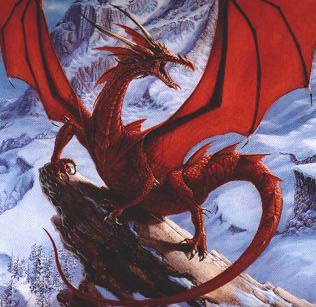|
Physical
 Western Red Dragon
Western Red Dragon

Eastern Black Dragon

Western Green Dragon

Dragon Skull
Anatomical Pictures
The extirior of a Dragon
The skeleton of a Dragon
The muscles of a Dragon
|
Dragons are large reptilian creatures, with a strong lair of scales and cold blood in their veins. They usualy grow to be fairly large, lengthing between 15 - 30 feet, from head to tail, weighing close to a ton or two.
Dragons are divided into two major racial classifications: Western and Eastern. There is also a classification for other dragon-like creatures, called Dragonkin. Dragonkin are pseudo-dragons, consisting of the Wyvern, Drake, Sea-Serpents and many other races that I'm not going to talk about. Dragonkin are actually not dragons themselves, but are closely related.
As for Western and Eastern Dragons; Westerm Dragons take the body shape of winged lizards, While Eastern Dragons have a more serpent-like appearence.
Dragons have slim, horned heads flanked by a pair of spiny frills atop Long muscular necks. The Jaws of a dragon are fairly large and powerful, able to swallow a man whole (should the dragon find need too).
Western Dragons have large, strong leathery wings, used to acheive flight. Most Eastern Dragons do not have them, but can still acheive flight (Discussed in 'Special Features; Flight').
Lastly, Dragons have long, thick tails, usualy tipped with a blunt or sharp end, used in attack. Tails are a good offensive weapon, mainly because they are the strongest apendage on a dragon's body.
Breeds
There are thousands of different breeds of dragons, across the globe. Some have many horns, some have smooth scales, some have hair. Too date, there is no acurate count of all the breeds of dragons. There are many that look similar, but have small differences which set them apart.
The most common way to classify the breeds of dragons are by the colors of their scales. The most common Breeds then are Red and Green, but there are also large numbers of blue, white, gold, black, brown, and many other colors, or combinations of colors. There are a few breeds with two colors, which come from crossbreeding.
So, the only way dragon breeds are cataloged, are as Red, Green, Blue, etc... But each catagory contains hundreds of different races.
Skeleton
Dragons have very thick, heavy bones for an avian. Their skeletons make up close to 45% of their body weight, and an entire skeletal structure of a grown adult can weigh up to 700 lbs.
Dragons have partialy-hollowed bones, for flight, but they are still very sturdy for combat. It is almost impossible to break a dragon's bones, especialy their pelvis, ribs, and theigh bones. They are most fragile in their wings, the longest and thinest bones.
Inside the bones are little pockets, which is where hydrogen needed for fiery breath and to help make a dragon lighter is stored.
|


